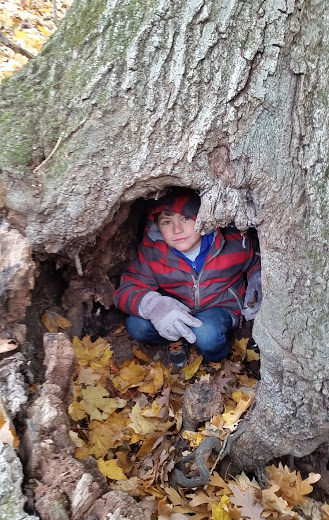Sit a While

Written by Julie Pacholik.
At Crow’s Path, elementary school children spend one full day with five mentors in the forest, meadow, and shoreline of Burlington, Vermont. Every day, 25 kids and five staff members, including me, spread out around our camp at Rock Point and sit quietly at our very own Sit Spot. It’s a special spot that is chosen in the fall; a special spot we return to once a week; a spot situated in such a way that we can’t see any other people. It is a place and it is also a practice.
The goal is to sit quietly for in the woods for 10 to 20 minutes. But if that’s not possible, the sitter can sing a quiet song or create a small building project. When time’s up, a crow call goes out and then, echoed by each of us, a wave of sound cascades across camp. Without a word, everyone stands and makes their way back to the fire circle. A child once described Sit Spot as a time when we “sink into the land.”
The choosing of the Sit Spot and learning to make the sound of crow, these things take time to figure out. Every week, the same group of kids return and, in month or two, our Sit Spot routine is set. At Crow’s Path, the interests and skills of the staff guide each day’s activities while weaving in the kids’ own curiosity. Everyday is different. But Sit Spot is one of our many core routines, which also include making fire, giving thanks, and story telling. It is the container in which holds us all, mentors, interns, and kiddos. Sit Spot takes place every day the kids come to Crow’s Path from fall through winter into spring.
Sit Spot is always the same spot. There is beauty and possibility in this challenge but some days it can feel mundane and routine. This is why each day before heading out, a mentor speaks to the joy of Sit Spot. It might be an inspiring story of an exceptional Sit Spot experience, like my friend in Alaska who smeared peanut butter into his bushy beard and coaxed a woodpecker into landing on it. The story could also be a challenge to build something in the snow, tips about finding a dry, protected spot on a rainy day, an invitation to notice the bird song or tree buds, or a thought to find a new pathway to and from your Sit Spot. Having the same spot encourages us to make it new and make it ours. And the ever changing seasons in Vermont helps make it new minute by minute.
The Sit Spot practice was introduced through the books and leadership of Tom Brown, Jr., a New Jersey native, who met an Apache elder while exploring the woods with his friend Ron. Affectionately known as Grandfather, this elder taught Tom and Ron how to live with the land, passing on as much as he could to these two young boys, including the practice of Sit Spot. Jon Young, a student of Tom Brown Jr.’s, wrote an in depth guide book to nature connection, The Coyote’s Guide to Connecting with Nature. This book has become the Bible of many outdoor schools. These men brought this custom to communities across the nation, but it is a practice as old as people’s connection to the land. Humans living close to the earth or wanting time to sit and reconnect have been finding special spots as long as humans and special spots have existed.
One of my favorite Sit Spot memories in Burlington occurred when, after a warm winter day followed by snow, I watched as squirrels tried to scamper their usual routes but kept slipping on the invisible ice under the snow on the high branches. They had always seemed so sure-footed and brave. But that day at my Sit Spot, I saw a squirrel walk carefully, gingerly on the trees.
Sit Spot is not all wildlife sightings or beautiful bird songs, sometimes it can be a struggle. On cold days or times when kids would rather spend time with friends than be alone this practice is just hard. There have been times when I hear shrieks of joy or giggles during our normally quiet time and would softly make my way over to the noise makers, I would explain a pillar of sit spot time was quiet and alone, they would push back claiming, “I hate sit spot!” I have come understand that these children were afraid of being alone. They felt scared by themselves and so sought out the company of friends.
That makes so much sense! Elementary-aged children are never alone. Between parent supervision, school, play dates, sports teams, play practice, and siblings, children rarely experience true quiet or alone. We would find some arrangement where the kids would know where the mentors’ sit spots were and could shout to us if needed but found a place that could be theirs. The beauty of doing sit spot as a group is that you don’t need to be alone. You just need to feel alone. If you are behind a tree, on a slope, you can’t see your friends even if they are four steps away.
I’ve learned beautiful lessons and I’ve seen first hand the sparkle in a child’s eye after returning from Sit Spot and seeing the first spring flower or noticing animal tracks in snow. It takes commitment and sometimes a little encouraging but the awe is inevitable. I encourage you to start your own Sit Spot practice. Find a wild space close to home in one of Burlington’s many urban wilds: in a park, along a trail, even a cemetery is filled with wildness just waiting to be seen.
